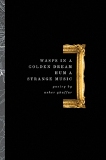June 20, 2010WASPS IN A GOLDEN DREAM HUM A STRANGE MUSIC
Review by Craig Santos Perez
ECW Press
2120 Queen Street East
Suite 200
Toronto, Ontario
M4E 1E2
ISBN 1-55022-854-4
2008, 121 pp., $16.95
www.ecwpress.com
Asher Ghaffar’s first book, Wasps in a Golden Dream Hum a Strange Music is divided into five parts: “Induction,” “Deduction,” “Conduction,” “Production,” and “Disruption.” But there are deeper divisions throughout the work: the partition between India and Pakistan; geographic and physical borders; the gap between native and adopted tongue; the distance between the past and the present, memory and language, prose and lyric.
“1947,” the year of partition, appears throughout this collection like an inscription of trauma. The first three poems powerfully situate the work within the border created in that year. It begins, appropriately, with “Genesis”:
In the age of surveillance, the border is where one discerns the pulse of a nation. The border is the inverse of the wide expanse of the frontier where we envision ourselves as infinite and unruly—where we come to know ourselves, embodied in divisive histories. Jarred out of ourselves—we never knew ourselves until we were suspended between worlds.
The prose poem continues with the speaker being interrogated on the Indian side of the Wagah border, the precise place his “family crossed, did not cross” in 1947. The themes of borders and migrations shape the speaker’s narrative: “Plates underneath the earth could quake or cleave and forge another / signature. We shift from India to Pakistan to Canada” (“Mapping the Furnace Room”). Canada, the current residence of Ghaffar, also becomes an important location in the book: “O Canada of hinge narratives. O Canada of opening and closing doors” (“Predictably, The House Was Not There”).
Where and what is home to an immigrant? In “Introduction to a Home,” we read: “Home emerges from simultaneous pasts intersecting and creating homes that never were, but here, in this space, it is possible to build another home every morning, to unimagine the border that is now locked.” Home is a difficult image throughout, a place that is continually being mapped and unmapped. The figure of home is haunted by the migrating figure of the father. We don’t receive a chronology of the father’s life; instead, Ghaffar provides brief details: “Then he would leave for months without a word. A few weeks later we would receive a letter: ‘I will be back.’ These four simple words were like inscriptions in the heart. They were like the knobs of a door into the blackness of a night without stars” (“In Possible Departures”). Many of the poems seek to remember, imagine, and heal the father’s life: “One can never break off because in dreams one is saving a drowning, displaced father” (“Dog Days”).
Besides poems about family, home, and migration, many pieces explore memory, language, and narrative. While at the Wagah border, the speaker “imagined stories,” but these stories did not necessarily come in the form of a traditional poem: “I seek a form for the body in crisis, a form in alliance with the flight of bees. I search the archive for the voice that will break the density further. I seek a drive that is not the drive for death, but the drive for the everlasting life of fervour” (“Genesis”). Ghaffar’s oscillation between prose and lyric seeks the form for his experience, “for the body in crisis.” At times, Ghaffar’s poems move shapelessly, at times they are bound by time and space. In “On the Question of a Borderless Body,” Ghaffar further explores the relationship between borders and narratives: “Every narrative crawls our of another, before arriving at a border.” In turn, the poem discusses the relationship between self, mind, and narrative:
The border transmigrates into his mind, so he can discern where he came from and what he might be, as a threshold. If he is a threshold, if he can speak from two cosmologies at once, united into a cosmology of loss—linked chain by chain to rupture, which arranges itself into mutated syllables.
Ghaffar speaks from various cosmologies of loss and hope, speaking in fragments and changing syllables. The very next poem, “In Possible Departures,” Ghaffar muses that “perhaps poets are created from threshold worlds—from languages left behind, their sanguine music lingering on the palate.”
Crossing between narratives, Ghaffar emphasizes the importance of memory and dreams for those who are created from threshold worlds. The strange music of this book is a dream music: “Ever since I was young, I’ve seen how dreaming shaped the waking body.” Not only does dreaming shape the body, but it also shapes memory: “A pure memory is a fossil. And memory needs a mooring image. / A dream to live on” (“Mis/Match”). The images throughout are often dreamlike themselves—sometimes surreal, sometimes impressionistic, always unforgettable. In many ways, Wasps in a Golden Dream Hum a Strange Music is a story of a map. More precisely, a story of mapping, a seeking of thresholds and wholeness:
I learned to listen with ears and a broken tongue. The towers of this language. This body. Lost tongues converging. There are reeds that can be broken and remade into pipes that siphon voices from the undertow. Those lost bodies are in the body, those lost voices want only to sing. If they don’t swallow us whole, they take us in piece by piece. Until we learn their languages. Until we break. Their brokenness. One day. Will make us whole (“Pre Face”).